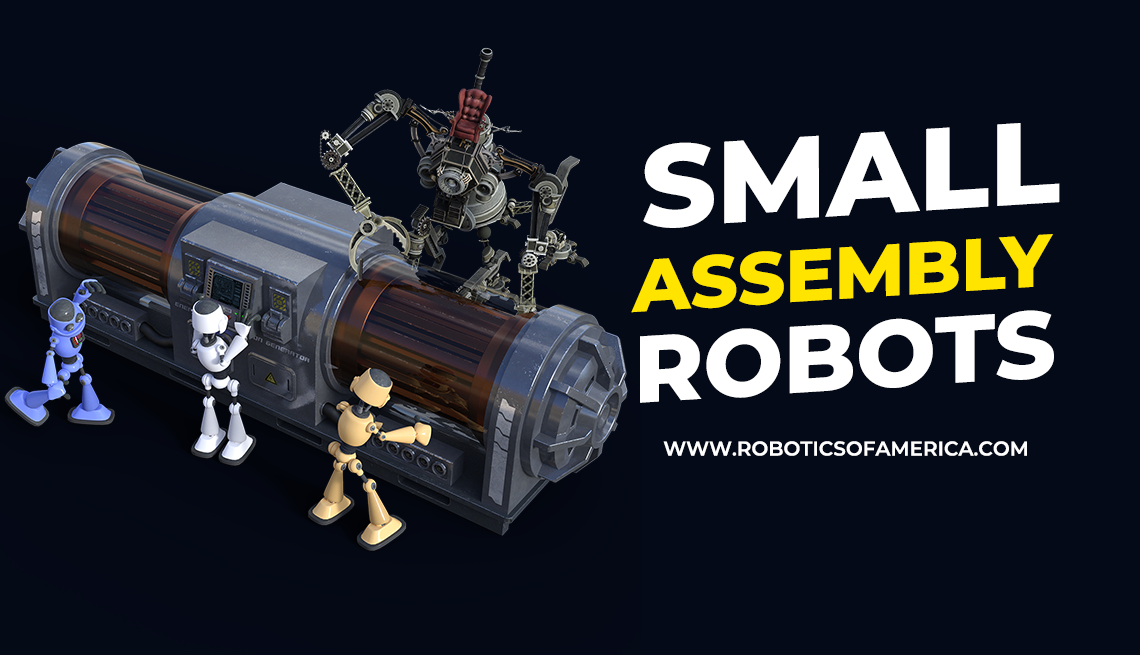
Small Assembly Robots Provide Companies With Big Benefits
Small assembly robots are becoming more and more important for many organizations. That’s because these little robots offer big benefits toward many industrial processes. Whether it’s packaging, manufacturing, or something else- expect results from these robots. The number of options for small assembly robots is growing by the year. The marketplace is expanding faster than ever before. Companies have plenty of choices when it comes to selecting small robots. The range of options can seem confusing for many people. But that’s why Robotics of America is here to help. We are your number one resource when it comes to help selecting quality robots and parts. Are you ready to learn more about small assembly robots? Let’s get started.
What Are Small Assembly Robots?
Small assembly robots are a classification of robotic arms. Every small robotic arm features either a four-axis or six-axis set-up. The four-axis sets often gets referred to as SCARA. Companies have plenty of options when it comes to selecting one of these robots. And organizations cannot let the name fool them. Small assembly robots do a lot more than assemble. They can conduct a wide variety of tasks. The robots can do almost everything a human can do when it comes to industrial processes. In fact, small assembly robots can do some tasks that humans are unable to do. The majority of companies use the robots for packaging and manufacturing. But expect more organizations to adopt them as robotic technologies evolve.
You might wonder what factors classify a robot as a small assembly robot. Robots fall under this classification when they have a payload capacity up to 44 pounds. Plus, they all can reach objects up to 51 inches away. Keep in mind that larger robots are very different from small assembly robots. Larger robots feature different forms of motors, arms, joint construction. Plus, larger robots have different maintenance requirements.
The Pricing Structure of Small Assembly Robots
The cost-of-ownership varies a lot between large and small robots. Different robot brands provide different costs for small and large robots. The cost comes down to the exact type of equipment that gets used. Robotics companies will often provide an initial quote for small assembly robots. But never take the quote at face value. A lot of companies then supply add-ons. The price of add-ons can vary from low to high costs. Again, it all comes down to the industrial processes involving your organization.
What is the main challenge for small assembly robot buyers? It is to figure out which robots (and parts) affect specific company operations. If you need help finding a small assembly robot supplier, please contact our firm right now. We will assess your business needs and help you find the best small assembly robots. Plus, we will find you the greatest deal possible so that you save a lot of money. Our experts will help you locate the most high-quality robots such as:
-Six axis small assembly robots
-SCARA small assembly robots
-Delta robots
-Dual-arm robots
The Controllers of Small Assembly Robots
Controllers are one of the most important accessories of small assembly robots. A robot cannot function without a high-quality controller. Some manufacturers sell controlled and robot arms together as a package. Others do not feature a controller as part of the basic price. In fact, many robotics companies provide extra charges. These charges apply toward controller factors such as these:
-Motor cables for small assembly robots
-Encoder cables for small assembly robots
-Power cables for small assembly robots
-Electrical connectors for small assembly robots
The key is to find a robotics controller in which all features get activated. A lot of robot manufacturers can activate them at the same time. There is a common reason why some manufacturers can’t provide all the features. It is due to firmware and software licensing issues. That’s why post-sale charges often get applied toward small assembly robots. This pricing concept also applies to controllers. The extra charges will activate important features such as:
-Palletizing
-Singularity avoidance
-Collision detection
End-of-Arm Tooling Associated With Small Assembly Robots
End-of-arm tooling is an important concept involving small assembly robots. Every small robots is in need of a form of this type of tooling. In other words, small assembly robots can't function without end-effectors. A robots’ vision system relates to end-of-arm tooling. Not all small assembly robots have vision systems. But most do. It depends on the specific robotic application. EOAT and vision systems are often priced in a separate manner. But you can't only focus on hardware costs. You’ve also got to consider how easy or hard it is to integrate vision systems and EOT. The specifics of integration will contribute to the total cost.
The Software of Small Assembly Robots
Small assembly robot software packages can vary. Some companies sell programming-software packages. These often carry low base prices. But keep in mind that there are going to be upgrade options. And some upgrade options will cost a lot of money. Here are common software upgrades factors that apply to small assembly robots:
-3D simulation processes
-Remote monitoring
-Dispensing
-Palletizing
-Arm compliance
Keep in mind that some manufacturers make these features standard. Once again, it comes down to what you need your small assembly robot to do.
Training Programs for Small Assembly Robots
Are you having trouble learning how to use small assembly robots? If so, do not despair. There are plenty of robotic training programs available. In fact, a lot of assembly robot manufactures provide free training programs. But do not let the word “free” fool you. These programs are often extensive and take up a lot of time. Many companies dislike having their employees spending weeks learning about robots. Consider contacting Robotics of America for training advice. Our team of experts will direct you to the best program that meets your needs. Common training programs focus on end of arm tooling measures. They also teach employees how to use robotic vision systems.
The Main Tasks of Small Assembly Robots
Small assembly robots should get re-named as something else. Why? Because they do so much more than assembling. Below are only some of the tasks that these amazing little robots can do. And it’s a long list:
-Screw driving
-Nut driving
-Surface finishing
-Parts finishing
-Machining
-Test handling
-Ultrasonic welding
-Material removal
-Material handling
-Polishing
-Press fitting
-Loading and unloading
-Package forming
-Pick and place
-Product insertion
-Soldering spot-welding
-Assembly
-Dispensing
-Encapsulating and potting
-Grinding
-Insertion
-Inspection
-Labeling
-Laser welding
-Machine tending
Conclusion: Small Assembly Robots Are Making A Big Differences
Sure, small assembly robots are, well, small. But their value for companies across industry sectors is huge. As you can see from the above list of tasks, there’s little limit to what the robots can do. The key for success is to understand the small parts assembly process. Do not panic if your manufacturer isn’t helping you with the process. Instead, contact our firm today. We will help you put small assembly robots in place fast. Next thing you know, your company might experience boosts in ROI and profit margins. Please make sure you subscribe to our mailing list. We will update you about robotic industry insights to help you succeed. Below is some of the topics we will produce about in the future:
-Assembly Line Robots
-Robotic Assembly Systems
-How to Assemble Robots
-The Best Small Assembly Robots of 2020
-AI in Small Assembly Robots
-Automation Processes of Small Assembly Robots
-The Future of Small Assembly Robots
-Small Parts Assembly Tutorial
-The International Robot Safety Conference
-Robot Safety Measures
-The Future of Automation

